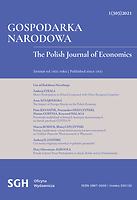Reguły polityki pieniężnej i makroostrożnościowej
w modelu z ograniczeniami zastawowymi
Macroprudential and Monetary Policy Rules in a Model with Collateral Constraints
Author(s): Piotr ŻochowskiSubject(s): National Economy
Published by: Szkoła Główna Handlowa w Warszawie
Keywords: collateral constraint; financial friction; macroprudential policy
Summary/Abstract: We compare the welfare and macroeconomic effects of monetary policy and macroprudential policy, in particular one targeting the loan-to-value (LTV) ratio. We develop a dynamic stochastic general equilibrium (DSGE) model with collateral constraints and two types of agents. In this set-up, we study seven potential policy rules responding to credit growth and fluctuations in the prices of collateral. We show that monetary policy responding to deviations in collateral prices from their steady-state value results in the highest level of social welfare. It is also useful in stabilising output and inflation. A macroprudential policy using the LTV ratio as the instrument is dominated in terms of output and inflation stability by interest rate rules. If interest rate rules are not available, the LTV ratio can be used to improve welfare, but the gains are small.
Journal: Gospodarka Narodowa. The Polish Journal of Economics
- Issue Year: 302/2020
- Issue No: 2
- Page Range: 43-69
- Page Count: 27
- Language: English

